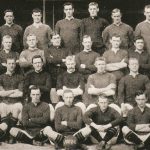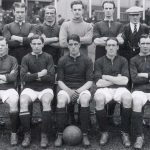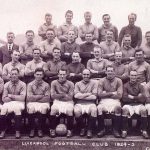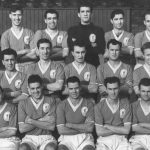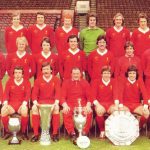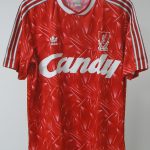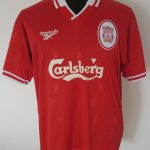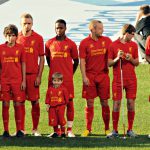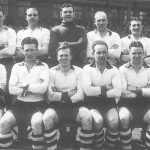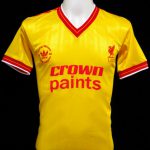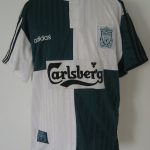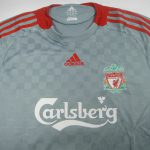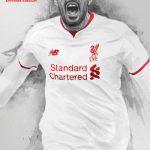Welcome to the Liverpool kit history page. This is the hub for Liverpool F.C. official game apparel, its colours and its visual history. Check the bottom of the page for all articles related to The Reds or view the club’s current shirt.
The Colours
Liverpool colours are all red. They have been this way since 1965, when the team changed the bottoms of their uniforms to match their red tops. Consequently, the team’s nickname is “The Reds” and the players don a full red ensemble for all home games. The away kits of Liverpool are currently all purple. During the times when the team needs to wear their third strip, they take the field all in white, with gray accents on the jerseys.
Check out Liverpool F.C. kit and gear here!
The Crest
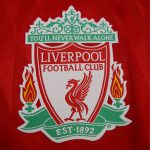 Liverpool F.C. crest is based upon the city’s coat of arms and features a red cormorant – referred to as the Liver Bird – on a white shield. The liver bird is the symbol of the city of Liverpool and its status dates back a number of centuries. Surrounding the shield are two eternal flames which commemorate a significant event in the club’s history – the Hillsborough disaster. The real flames can be seen at the Anfield stadium as part of a memorial next to Shankly Gates. The gates themselves are also represented in the crest, rendered in green over the shield. Finally, the words ‘LIVERPOOL FOOTBALL CLUB” are written above the liver bird. Underneath it, a ribbon shows the year of the club’s conception – 1892. Note that this crest no longer appears on the uniforms during games. When the players take the field, they instead wear a solitary the liver bird with letters L.F.C. underneath it.
Liverpool F.C. crest is based upon the city’s coat of arms and features a red cormorant – referred to as the Liver Bird – on a white shield. The liver bird is the symbol of the city of Liverpool and its status dates back a number of centuries. Surrounding the shield are two eternal flames which commemorate a significant event in the club’s history – the Hillsborough disaster. The real flames can be seen at the Anfield stadium as part of a memorial next to Shankly Gates. The gates themselves are also represented in the crest, rendered in green over the shield. Finally, the words ‘LIVERPOOL FOOTBALL CLUB” are written above the liver bird. Underneath it, a ribbon shows the year of the club’s conception – 1892. Note that this crest no longer appears on the uniforms during games. When the players take the field, they instead wear a solitary the liver bird with letters L.F.C. underneath it.
Home Ground: Anfield
Nickname: The Reds
Motto: This is Anfield
Anthem: You’ll Never Walk Alone
Liverpool Kit History
Home Kit
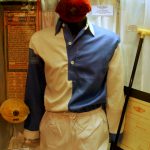
Liverpool Football Club was founded in 1892, after a disagreement between the directors of Everton FC and the owner of the Anfield football ground – John Houlding. Unwilling to pay the increased rent for the grounds, Everton ended its eight year tenure and moved to Goodison Park, leaving Anfield vacant. Left with a pitch but no team, Houlding formed his own team, originally registered as Everton F.C. and Athletic Grounds Ltd which became Liverpool F.C. the same year. The team won the Lancashire League in its debut season and joined the Football League Second Division in 1893, winning the trophy and earning a promotion to the First Division right away.
Upon its conception, Liverpool wore quartered light blue and white shirts and dark blue bottoms, which were likely just Everton kits left behind from previous seasons. In 1896, however, they changed their kits to red tops and white shorts, to reflect municipal colours. The shirts of that day were made of a relatively coarse fabric compared to the jerseys of today, had high collars and were buttoned at the neck. The socks were red.
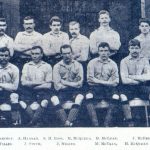
Liverpool F.C. won the first division in 1901 and repeated the feat again in 1906. It was fueled at the time by a number of Scottish players brought to the club with money from private investment. In 1907, the club changed its socks to black but in 1910 it returned them to their original red. In 1914, Liverpool reached its first FA Cup, loosing 1-0 to Burnley at Crystal Palace in London. It maintained its form well into the twenties, winning the League in 1922 and then again in 1923, but facing a slow decline shortly after.
In 1934, the socks briefly turned black again, although they were trimmed with red tops for most games. They lasted this way till 1936, when Liverpool switched to red and white socks in horizontal stripes. With this design, Liverpool won the league again in 1947 and reached its second FA Cup in 1950, defeated once more – this time by Arsenal. Unfortunately, a period of decline in form soon followed.
Click to enlarge
In 1959, Bill Shankly was appointed the club manager and begun the legendary re-emergence of the club. Under his leadership, Liverpool entered a golden era of success, winning the First Division in 1964, 1966 and 1973, and finally winning the FA Cup in 1965 and repeating the feat in 1974, as well as claiming the prestigious UEFA Cup in 1973. Ian Callaghan, Roger Hunt, Ron Yeats and Ian St John were the star players who formed the backbone of the teams of that era. In addition to turning the fortunes of the club and the establishing of the now famous Boot Room, Shankly’s tenure saw changes to the team’s uniforms for the first time in years. Upon his arrival the socks changed again to white, but in 1964 a bigger – and now iconic – change occurred. Liverpool went all red. This moment has been recorded by Ian St John in his autobiography, which reads:
“He (Shankly) thought the colour scheme would carry psychological impact—red for danger, red for power. He came into the dressing room one day and threw a pair of red shorts to Ronnie Yeats. “Get into those shorts and let’s see how you look,” he said. “Christ, Ronnie, you look awesome, terrifying. You look 7ft tall.” “Why not go the whole hog, boss?” I suggested. “Why not wear red socks? Let’s go out all in red.” Shankly approved and an iconic kit was born.”

While the above account is correct in regards to the shorts (Liverpool donned them for the first time for a game against Anderlecht), the red socks didn’t actually make an appearance till March 10 1965 during a fifth round FA Cup game. Since then however, the colours of Liverpool F.C. never changed again. “The Reds” as they have been known over decades, have conquered the world again and again in their iconic monochrome strip. Under the leadership of Shankly’s disciple – Bob Paisley – who accomplished even more than the master, through the iconic years of Kenny Dalglish and his next golden age, to the teams of today, Liverpool has been synonymous with its all-red strip. This is not likely to change any time soon. To see the club’s current kit, check here.
Click to enlarge
Sponsorship
The only alterations to Liverpool’s all-red strip after the change made by Shankly were the cosmetic trim variants so popular in the 80s and 90s and the names and badges of the team’s sponsors and kit manufacturers. From 1973 to 1985 the uniforms were made by Umbro. In 1985 the manufacturer changed to Adidas and in 1996 Reebok took over. Adidas returned in 2006, only to be replaced by Warrior Sports in 2012. In 2015, Warrior Sport’s parent company – New Balance – took over and has continued to make the iconic red uniforms till this day.
Likewise, Liverpool’s team sponsor has changed several times over the decades. The first English team to introduce a sponsor logo on the front of their jersey, the club displayed the name of Hitachi from 1972 to 1982, followed by Crown Paints (1982-1988), Candy (1988-1992), Carlsberg (1992-2010) and finally Standard Chartered. The sleeve sponsors were introduced into the Premier League in 2017, with “Western Union” appearing on the side of Liverpool shirt the same year.
Away Kit
The first away uniform of Liverpool F.C. was a white shirt and dark blue bottoms. The shorts and the socks were probably re-used from the home strip and this tradition may have continued for some time afterward. The white shirts were likely the easiest to get at the time, given the short timeframe the club had to organize itself after the departure of Everton from Anfield. When the team switched their home shirts to red in 1896 however, a new set of white shirts was bought and paired with black pants and socks to modernize the away kit.
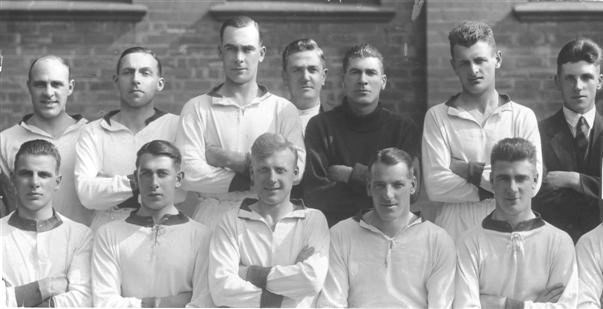
The uniforms of that time were woolen and relatively coarse compared to the marvels of clothing we have today. They were often outfitted with collars and were either laced up or buttoned at the neck. In 1900, the away kits of Liverpool switched to all white with red and later black socks and lasted that way till 1911. From 1911 to 1921, the club played in red and white striped shirts and the team was often refereed to as “stripes” by media during away games. Their shorts remained white while the socks stayed red. In 1921, the striped shirts were ditched in favor of an all white jersey.
1931 was the beginning of what may be called a tradition in away kit for Liverpool. That season, for the first time, they donned their now famous white and black kits. White shirts and black shorts would remain with the team till the end of the 1981-1982 season and during that time only the socks changed appearance twice. They started as black, turned to red and white hoops to match their home socks in 1938 and finally settled on white in 1957. This black and white shirt/short pattern would stay with the team as iconic and would return periodically for select seasons even after 1982.
Click to enlarge

At the end of the 1970s, the team introduced an all yellow version of Liverpool uniform as their third kit and in 1982 it upgraded this kit to their second. White and black would return occasionally for two seasons, but the image of Liverpool playing their away games in yellow during the eighties has been etched quite strongly into the team history. Two more measurable changes occurred shortly after. Adidas changed the yellow to all gray between 1987 and 1989 and then again to green till the 1995-1996 season… the last change causing quite a stir among the fans. The nineties were also an era of bold visual patterns on football uniforms and Liverpool had its share of those.
From 1996 on, all bets were off. The away strip now changed from year to year without any consistency between seasons. The most common colours have been yellow, black and green. The iconic white and black strip from the fifties would make an appearance every now and then, but now quite embellished with colourful trim. To this day, the change uniforms of the great Liverpool club show no consistency between seasons, while their home strips remains loyally red.
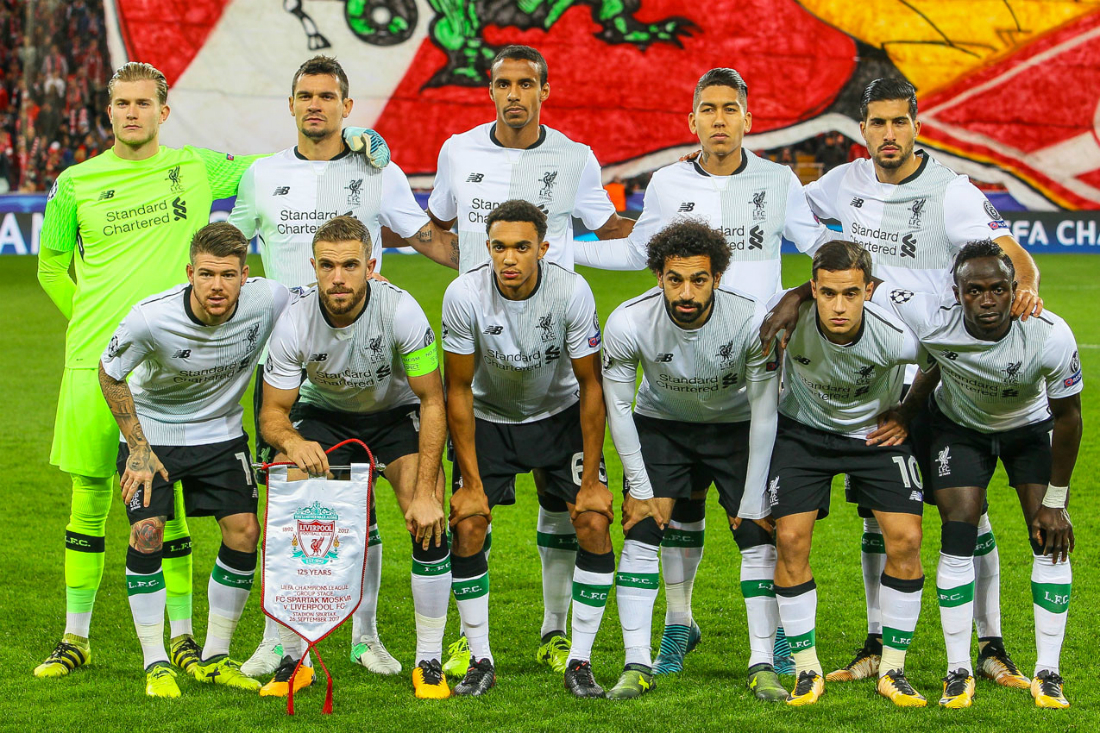
Liverpool Badge History
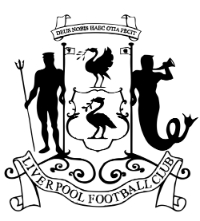
While Liverpool FC adopted the liver bird (the city’s emblem) as their first badge in 1901, the design didn’t appear on their uniforms. This was the custom of most English clubs of the era and it continued for decades. Instead, the liver bird could be seen on flags, programs and official documents of the club. It went through several renderings in the first few decades, most of which are now lost to posterity. In addition to the bird itself, the club often used a modified Liverpool coat of arms as its symbol, especially on programmes starting in the mid thirties, when it no longer shared those with Everton.
When the liver bird finally appeared on the uniforms it was white on a red shield. It was featured this way for the first time in 1950 FA Cup final against Arsenal, which Liverpool unfortunately lost 0-2. It disappeared from the shirt immediately after that game and re-emerged once again in 1955, this time permanently. This new permanent logo was however somewhat different. The shield changed its shape to an oval and the colours were reversed – a red bird featured on a white background. Underneath it were letters L.F.C.
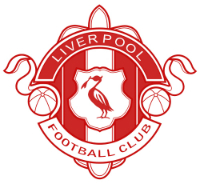
The next official redesign of the crest – as it appeared on the uniforms – came in 1968. The liver bird turned white once again and was embroidered directly onto the shirt, with no background. The letters L.F.C. remained and in 1976 both the letters and the bird turned gold. They stayed that way till the 1985-1986 season, when Adidas took over as the shirt manufacturer of the club and reversed the colour back to white. It is important to note that all through the 50s, 60s, 70s and even well into the 80s alternate versions of the club’s badge existed. These alternate badges were used in print and on merchandise and all featured a version of the liver bird but usually with added stylistic elements around it. One such example can be seen to the right. The disparity between those alternate crests and the ones used on the shirt grew over time. In 1987 however, it came to an end when the shirt crest was altered to match the merchandise one and a standard crest of Liverpool emerged. This new, unified version had the liver bird back on a red shield with words “Liverpool Football Club” underneath.

The 80s proved to be a memorable decade for the club, in both great and tragic terms. Led by the now legendary Kenny Dalglish, the team experienced a golden age and dominated stadiums both in England and around the world. Yet it was also in this decade that saw two tragic events. The 1985 Heysel Stadium disaster and the 1989 Hillsborough tragedy left a mark on both the club and the football world itself. In 1992 the club issued a new badge for its 100 year anniversary and the following season in 1993 the badge was modified to include two eternal flames which represent the Hillsborough memorial outside Anfield gates. The gates themselves – known as Shankly Gates – were rendered at the top the crest, complete with the title of the club’s anthem “You’ll Never Walk Alone”.
In 1999, another redesign occurred. The changes were mostly cosmetic, but they introduced the colour green to the crest in significant amounts. Specifically, the Shankly Gates were now rendered fully in green, as was the ribbon under the shield. The eternal flames became more stylized and the letters “Liverpool” were now white on red background, which made them stand out more proudly. While this crest no longer appears on the kits, it still exists as the official logo of the club on all official merchandise and can be found at the front of the Main Stand at Anfield. In 2012 however, it was retired from the shirts in favor of a simple yellow liver bird with “L.F.C” embroidered directly onto the shirt.
In 2017, the club issued a special commemorative crest to mark Liverpool’s 125 anniversary. The letters “125 YEARS” were added under the bird and the dates 1892 and 2017 were posted around it.
Liverpool Kit History – ChampionsLeagueShirts.com
Image sources: 1, 2, 3, 4, 5, 6, 7, 8, 9, 10, 11, 12, 13, 14, 15, 16, 17, 18, 19, 20, 21, 22, 23, 24, 25, 26
RELATED POSTS
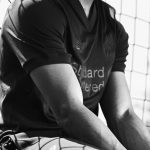 Liverpool Pitch Black Shirt – 125 Years of Glory- Liverpool Pitch Black Elite shirt - the anniversary collectible In 1892, Liverpool Football Club has been formed in Merseyside, the city of Liverpool, at the Anfield stadium. In 2017, the franchise celebrated its 125 anniversary. To immortalize this occasion, the club issued commemorative kit. Specifically, this meant an all-black wearable collection, which the kit manufacturer of the club - New… [...]
Liverpool Pitch Black Shirt – 125 Years of Glory- Liverpool Pitch Black Elite shirt - the anniversary collectible In 1892, Liverpool Football Club has been formed in Merseyside, the city of Liverpool, at the Anfield stadium. In 2017, the franchise celebrated its 125 anniversary. To immortalize this occasion, the club issued commemorative kit. Specifically, this meant an all-black wearable collection, which the kit manufacturer of the club - New… [...]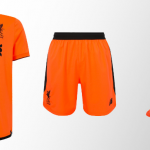 Liverpool Third Kit Socks- While the orange shirt has met with mixed reviews after being released for the 2017-18 season, the Liverpool third kit socks have been a surprising hit with the fans. No doubt, it's the novelty of wearing something different, something bright, as well as the revent popularity of bold colors. Liverpool Third Kit Socks Inexpensive and durable, the socks… [...]
Liverpool Third Kit Socks- While the orange shirt has met with mixed reviews after being released for the 2017-18 season, the Liverpool third kit socks have been a surprising hit with the fans. No doubt, it's the novelty of wearing something different, something bright, as well as the revent popularity of bold colors. Liverpool Third Kit Socks Inexpensive and durable, the socks… [...]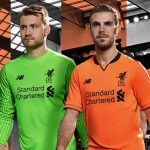 New Liverpool Football Kit – Orange!?- New Balance has released the third version of the new Liverpool football kit for 2017-18 season amidst bewildered looks and raised eyebrows. Bold colours once again seem to be the theme of this year's rendition. Before we tackle the controversy however, let's have a look at the standard design elements of the jersey. New Liverpool Football Kit - Orange… [...]
New Liverpool Football Kit – Orange!?- New Balance has released the third version of the new Liverpool football kit for 2017-18 season amidst bewildered looks and raised eyebrows. Bold colours once again seem to be the theme of this year's rendition. Before we tackle the controversy however, let's have a look at the standard design elements of the jersey. New Liverpool Football Kit - Orange… [...]

